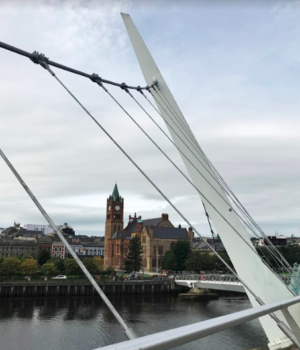Written by Charissa Roberson
After months of anticipation, it’s surreal to look out my window and see the huge River Foyle flowing through the city of Derry, splitting it in two. I only arrived two days ago, and as you can imagine, I was eager to explore.
Amazingly, the weekend I arrived was also the weekend of EHOD. What’s that? Turns out there’s certain days, called European Heritage Open Days, where tours and museums are free! So while the day was still young, I headed out to explore my new home. What with visiting museums, admiring the buildings, walking the streets, and taking a tour of the city walls, I ended up spending about 7 hours wandering about (oops). Turns out, Derry is even more fascinating than I had thought from afar.
Conflict, a deep-running theme in the city’s history, is etched into the very physical make-up of Derry. The River Foyle is used to separate the two communities of Catholic Nationalists and Protestant Unionists, those who want to be part of Ireland and those who want to remain in the UK. Now, the city has literally built a bridge across this divide—a spectacular piece of architecture, aptly named the Peace Bridge. It stretches across the river and links both sides of the city.
Memories of the decades of trouble are still clearly visible wherever you look, from the Irish and British flags flying over different sections of the city, to the striking murals emblazoned on the walls, to areas that are still locked up as a precaution against violence. While these indications of tension stand out boldly, so do the markers of peace. An eternal Peace Flame stands beside the magnificent Guildhall, surrounded by pledges from the people of the city to uphold peace, love one another, and strive for a brighter future.
The future of Derry looks bright indeed. In 2013, it was named the City of Culture, and with one of the youngest populations in Europe, Derry is a vibrant and lively place, full of people who are ready and eager to take on the years ahead.




